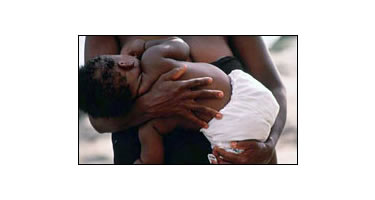The issue of exclusive breast-feeding for the first year has been an area of confusion for many mothers in developing nations, especially following the marketing practices of many formula companies to push products in a misleading manner, an issue about which I have previously written.
However, for mothers who are HIV-positive, especially in sub-Saharan Africa, exclusive breastfeeding is the most practical option. According to a large African study Kesho Bora, placing HIV-positive mothers on a combination of three antiretroviral (ARV) treatments during pregnancy, delivery and breastfeeding cuts HIV infections in infants by 43 percent by the age of 12 months, and reduces transmissions during breastfeeding by 54 percent. The African study and practice comes into direct conflict with the World Health Organization’s (WHO) 2006 recommendations, which advises that ARV drugs be given to mothers only through the time of delivery.
Yet the WHO 2010 guidelines recommend exclusive breastfeeding with an ARV treatment intervention for the first six months of a child’s life to reduce transmission, and continued breastfeeding, with formula or other foods, until the child is at least a year old. Alternatively – where it is acceptable, feasible, affordable, sustainable and safe – WHO recommends complete avoidance of breastfeeding. The biggest problem has been that the latest guidelines on infant-feeding options for HIV-positive mothers in Africa have not been disseminated in many countries, leaving women confused about the best nutritional path to protect their children from contracting the virus, and therefore leaving infants at greater risk.
“The six months of exclusive breastfeeding is what is crucial for mothers to understand – that not doing it is what raises the child’s HIV risk; but we are finding that while many countries have officially adopted the WHO guidelines, they have not trickled down, and health centres, policy-makers and communities are still unclear on what advice to give mothers,” said Aditi Sharma, of the International Treatment Preparedness Coalition (ITPC), and coordinator of the report The Long Walk: Ensuring comprehensive care for women and families to end vertical transmission.
Another view can be found in a new report by community health workers from Cameroon, Cote d’Ivoire, Ethiopia and Nigeria, that was launched at the 16th International Conference on AIDS and STIs in Africa (ICASA) in Addis Ababa, Ethiopia. Research found that prevention of mother-to-child transmission programs were focused too narrowly on the provision of ARVs to HIV-positive pregnant women, rather than more comprehensive approaches that involved family planning, maternal healthcare and exclusive breastfeeding.
It is clear that a clear and concise plan must not only be established but promoted on a global scale by all development agencies to ensure that mothers and children are safeguarded and a sustainable effort to lower HIV transmissions is in our future. According to the International Treatment Preparedness Coalition (ITPC), more in-depth delivery prevention of mother-to-child services in Africa are greatly needed.
“Countries must ensure that policy filters down to the women in all aspects of PMTCT – from HIV prevention for women to family planning, to the best ARV prophylaxis option to proper infant feeding to proper healthcare for the mother, child and family,” Aditi Sharma, Co-Coordinator of the Treatment Monitoring and Advocacy Project (TMAP) said. “It is the only way we can achieve the 2015 targets of reducing vertical transmission by 90 percent (IRIN).”
